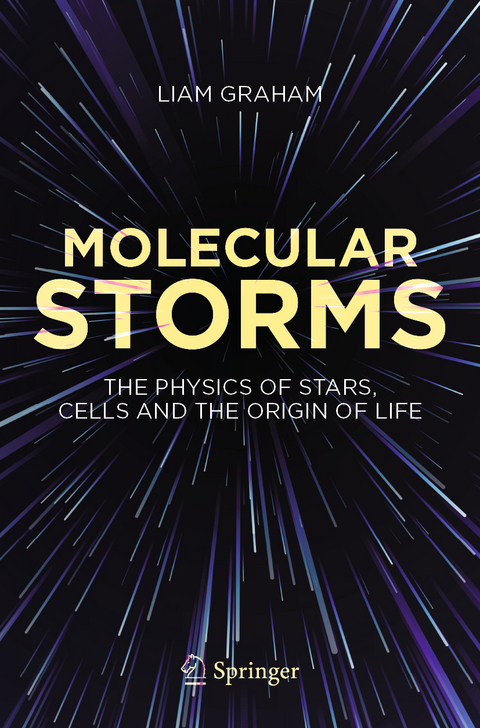
Molecular storms
Springer International Publishing (Verlag)
978-3-031-38680-0 (ISBN)
Nicki Hayes, CCO, The Communications Practice, author of First Aid for Feelings.
"Only a few writers have managed to turn the highly technical jargon of science into language accessible for interested lay readers. Isaac Asimov showed us how it could be done, and Carl Zimmer and Brian Greene are continuing today. In Molecular Storms, his first book, Liam Graham has shown that he has the essential quality required to join this group, a love of first learning then explaining how the universe works."
David Deamer, Professor of Biomolecular Engineering, University of California, Santa Cruz, author of Assembling Life.
Why is the universe the way it is? Wherever we look, we find ordered structures: from stars to planets to living cells. This book shows that the same driving force is behind structure everywhere: the incessant random motion of the components of matter. Physicists call it thermal noise. Let's call it the molecular storm.
This storm drives the fusion reactions that make stars shine. It drives whirlpools and currents in atmospheres and oceans. It spins and distorts molecules until they are in the right orientation to react and form new substances. In living cells, it drives proteins to fold and molecules to self-assemble. It is behind every detail of the astonishing molecular machines that control cellular processes.
Using cutting-edge research, "Molecular Storms" takes us on a dazzling journey from the early universe to the interior of the smallest living things. There, in a nanoscale world of biological devices, it explains the physics behind the chemical system which we call Life.
Whether you're someone with a general interest in science or a student looking to add context to your studies, this book is for you. "Molecular Storms" is an accessible and captivating read that will deepen your appreciation of the power of science to explain the world.
"Do we need more than physics to understand the world?" Liam Graham first asked himself this question as a teenager and it has been the driving force behind his career ever since. After a degree in Theoretical Physics at Cambridge and a master's in Philosophy at Warwick, he eventually found economics to be an appealing middle ground and completed a PhD at Birkbeck College, London. To pay the rent, he taught English, developed and sold trading software and was the numbers' guru for a boutique finance house.
Liam's 15 year academic career was mostly spent as an Associate Professor at University College London, working in one of Europe's top Economics departments. His research involved building mathematical models of an extremely complex system, the macroeconomy, and his work was published in all the top macroeconomics journals. Whether working on philosophy or economics, he never stopped reading science and exchanging with scientists. In 2018 he left UCL to concentrate on his original question and the wide-ranging, multidisciplinary and endlessly fascinating project it has become.
Introduction.- Random Patterns.- The Molecular Storm.- The Joy of Thermodynamics.- The Engines of Creation.- From Big Bang to Big Freeze.- How Chemistry Works.- Lively Molecules.
"Graham displays a magisterial command of the material ... . a thought-provoking reflection on the deepest of questions." (Kirkus, Kirkus, kirkusreviews.com, November 3, 2023)
"His grand tour of the physical world leaves little unexamined, starting with simple systems of gas molecules in a box, moving to the smallest, simplest living cells, then on to whole planets. Graham does a stunning job of connecting everything to the state of disorder we call entropy and to the driving force behind structures everywhere - the 'molecular storms' of his title." (Karmela Padavic-Callaghan, New Scientist, newscientist.com, January 3, 2024)
“This book is suitable for ‘all those who are curious about how the world works’; readers will need more than mere curiosity to understand this often-challenging work. But it’s as lucid an exposition as one could reasonably expect, given the technical nature of the subject, and it’s a thought-provoking reflection on the deepest of questions. A stimulating exploration of thermodynamic science.” (Kirkus Indie, Kirkus, kirkusreviews.com, November 3, 2023)
| Erscheinungsdatum | 03.11.2023 |
|---|---|
| Zusatzinfo | Illustrationen |
| Verlagsort | Cham |
| Sprache | englisch |
| Maße | 155 x 235 mm |
| Gewicht | 446 g |
| Themenwelt | Mathematik / Informatik ► Mathematik ► Wahrscheinlichkeit / Kombinatorik |
| Schlagworte | Bioenergetics • Biological Nanomachines • Biological Nanomotors • Biological Ratchets • Biological Self-Assembly • Complex Systems • Dissipative Structures • Macromolecular Crowding • Maxwell's demon • Maxwell’s Demon • Metabolism • negentropy • origin of life • Statistical Mechanics • Thermodynamic Engines • Thermodynamics of Life |
| ISBN-10 | 3-031-38680-9 / 3031386809 |
| ISBN-13 | 978-3-031-38680-0 / 9783031386800 |
| Zustand | Neuware |
| Informationen gemäß Produktsicherheitsverordnung (GPSR) | |
| Haben Sie eine Frage zum Produkt? |
aus dem Bereich


